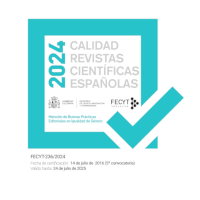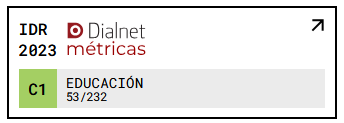Analysis of the empowerment factors of specialist teachers in the inclusive education of children aged 6-16 with hearing difficulties
DOI:
https://doi.org/10.18172/con.3895Keywords:
Factors of teacher empowerment, inclusive practices, children with hearing difficulties, factor analysisAbstract
This study has analysed the factors of empowerment of tutor teachers on the inclusive education of 6-16-year-old children with hearing difficulties. The study sample consisted of 297 teachers from Gran Canaria and Tenerife. The Inclusion Questionnaire (IQ) was used based on the Index for Inclusion, composed of three dimensions: Culture, Politics and Inclusive Practices. The primary analysis included an exploratory factor analysis. The results indicated that teacher empowerment for the integration of children with hearing difficulties in inclusive schools is supported by seven factors: professional development (DP), self-efficacy in the teaching of skills, inclusive leadership, technology management, family involvement challenges, expert thinking frameworks, and technological usability and universal accessibility. These findings imply delineating curricular changes for the Teacher degree. Inclusion becomes the core value of empowerment in the primary and transversal competencies of the subjects of the teacher certification degrees. Besides, we recommend the development of professional standards and teacher training courses for the inclusive education of children with hearing difficulties.
Downloads
References
Alegre, O. M. y Villar, L. M. (2015). Inclusión e interculturalidad. Un estudio en el marco de la enseñanza universitaria. Revista nacional e internacional de educación inclusive, 8(3), 10-12.
Amin, M., Till, A. y McKimm, J. (2018). Inclusive and person-centred leadership: creating a culture that involves everyone. British Journal of Hospital Medicine, 79(7), 402-407. https://doi.org/10.12968/hmed.2018.79.7.402.
Archbold, S. y Mayer, C. (2012). Deaf Education: The Impact of Cochlear Implantation? Deafness and Education International, 14(1), 2-15. https://doi.org/10.1179/1557069X12Y.0000000003.
Black, W. R. y Simon, M. D. (2014). Leadership for All Students: Planning for More Inclusive School Practices. International Journal of Educational Leadership Preparation, 9(2), 153-172.
Booth, T. y Ainscow, M. (2000). Index for inclusion. Bristol: Centre for Studies on Inclusive Education.
Bruce, S., Dinatale, P. y Ford, J. (2008). Meeting the needs of deaf and hard of hearing students with additional disabilities through professional teacher development. American Annals of the Deaf, 153(4), 368-375.
Caselli, M. C., Rinaldi, P., Varuzza, C., Giuliani, A. y Burdo, S. (2012). Cochlear implant in the second year of life: lexical and grammatical outcomes. Journal of Speech, Language, and Hearing Research, 55(2), 382-94. https://doi.org/10.1044/1092-4388(2011/10-0248.
Chao, C. N. G., Lai, F. T. T., Ji, M., Lo, S. K. y Sin, K. F. (2018). Which inclusive teaching tasks represent the highest level of teacher efficacy in primary and secondary schools? Teaching and Teacher Education, 75, 164-173. https://doi.org/10.1016/j.tate.2018.06.014.
Davenport, C. A. y Alber-Morgan, S. R. (2016). I Have a Child With a Cochlear Implant in My Preschool Classroom. Now What? Teaching Exceptional Children, September 2016. SAGE Publishing. https://doi.org/10.1177/0040059916651430.
De Boer, A., Pijl, S. J. y Minnaert, A. (2011). Regular primary schoolteachers’ attitudes towards inclusive education: a review of the literatura. International Journal of Inclusive Education, 15(3), 331-353. https://doi.org/10.1080/13603110903030089.
Deng, M., Wang, S., Guan, W. y Wang, Y. (2017). The development and initial validation of a questionnaire of inclusive teachers’ competency for meeting special educational needs in regular classrooms in China. International Journal of Inclusive Education, 21(4), 416-427. https://doi.org/10.1080/13603116.2016.1197326.
Jachova, Z. y Karovska, A. (2008). Analyses of the Teacher-Pupil Interaction Within the Inclusive Classroom-Case Study of a Child With a Cochlear Implant. The Journal of Special Education and Rehabilitation, 9(3-4), 7-22.
Jachova, Z. y Kovacevic, J. (2010). Cochlear implants in the inclusive classroom: a case study. Support for Learning, 25, 33-37. https://doi.org/10.1111/j.1467-9604.2009.01436.x.
King, S., Boutilier, J. A. y Chorne, J. M. (2018). Managing Chronic Pain in the Classroom: Development and Usability Testing of an eHealth Educational Intervention for Educators. Canadian Journal of School Psychology, 33(2), 95-109. https://doi.org/10.1177/0829573516674308.
León, M. J., Crisol, E. y Moreno, R. (2018). Las Tareas del Líder Inclusivo en Centros Educativos de Zonas Desfavorecidas y Favorecidas. REICE. Revista Iberoamericana sobre Calidad, Eficacia y Cambio en Educación, 16(2), 21-40. https://doi.org/10.15366/reice2018.16.2.002.
Liakopoulou, M. (2011). The Professional Competence of Teachers: Which Qualities, Attitudes, Skills and Knowledge Contribute to a Teacher’s Effectiveness. International Journal of Humanities and Social Science, 1, 66-78.
Maskit, D. (2011). Teachers’ attitudes toward pedagogical changes during various stages of professional development. Teaching and Teacher Education, 27(5), 851-860. https://doi.org/10.1016/j.tate.2011.01.009.
Mather, J., Archbold, S. y Gregory, S. (2011). Deaf Young People with Sequential Bilateral Cochlear Implants: The Experience of Parents and Teachers. Deafness and Education International, 13(4), 173-198. https://doi.org/10.1179/1557069X11Y.0000000009.
Mayer, C. y Trezek, B. J. (2018). Literacy Outcomes in Deaf Students with Cochlear Implants: Current State of the Knowledge. The Journal of Deaf Studies and Deaf Education, 23(1), 1-16. https://doi.org/10.1093/deafed/enx043.
Miesera, S., DeVries, J. M., Jungjohann, J. y Gebhardt, M. (2018). Correlation between attitudes, concerns, self-efficacy and teaching intentions in inclusive education evidence from German pre-service teachers using international scales. Journal of Research in Special Educational Needs, 19(2), 103-114. https://doi.org/10.1111/1471-3802.12432.
Moeller, M. P., Carr, G., Seaver, L., Stredler-Brown, A. y Holzinger, D. (2013). Best Practices in Family-Centered Early Intervention for Children Who Are Deaf or Hard of Hearing: An International Consensus Statement. Journal of Deaf Studies and Deaf Education, 18(4), 429-445.
Montgomery, A. y Mirenda, P. (2014). Teachers’ self-efficacy, sentiments, attitudes and concerns about the inclusion of students with developmental disabilities. Exceptionality Education International, 24, 18-32.
Moran, K. y Larwin, K. H. (2017). Building Administrator's Facilitation of Teacher Leadership: Moderators Associated with Teachers’ Reported Levels of Empowerment. Journal of Organizational and Educational Leadership, 3(1), Article 2.
Özokcu, O. (2018). The Relationship Between Teacher Attitude and Self-Efficacy for Inclusive Practices in Turkey. Journal of Education and Training Studies, 6(3), 6-12. https://doi.org/10.11114/jets.v6i3.3034.
Priyadarshini, S. S. y Thangarajathi, S. (2016-2017). Effect of Selected Variables on Regular School Teachers Attitude towards Inclusive Education. Journal on Educational Psychology, 10(3), 28-38.
Punch, R. y Hyde, M. (2011). Social Participation of Children and Adolescents With Cochlear Implants: A Qualitative Analysis of Parent, Teacher, and Child Interviews. Journal of Deaf Studies and Deaf Education, 16(4), 474-93. https://doi.org/10.1093/deafed/enr001.
Rae, D. y Carswell, M. (2001). Towards a conceptual understanding of entrepreneurial learning. Journal of Small Business and Enterprise Development, 8(2), 150-158. https://doi.org/10.1108/EUM0000000006816.
Rekkedal, A. M. (2012). Assistive Hearing Technologies Among Students With Hearing Impairment: Factors That Promote Satisfaction. The Journal of Deaf Studies and Deaf Education, 17(4), 499-517. https://doi.org/10.1093/deafed/ens023.
Schraer-Joiner, L. y Prause-Weber, M. (2009). Strategies for Working with Children with Cochlear Implants. Music Educators Journal, 96(1), 48-55.
Sharma, U., Loreman, T. y Forlin, C. (2012). Measuring teacher efficacy to implement inclusive practices. Journal of Research in Special Educational Needs, 12(1), 12-21. https://doi.org/10.1111/j.1471-3802.2011.01200.x.
Sprott, R. A. (2019). Factors that foster and deter advanced teachers’ professional development. Teaching and Teacher Education, 77, 321-331. https://doi.org/10.1016/j.tate.2018.11.001.
Thurstone, L. L. (1928). Attitudes can be measured. American Journal of Sociology, 33, 529-554. https://doi.org/10.1086/214483.
UNESCO (1994). The Salamanca Statement and Framework for Action on Special Needs Education. Paris: UNESCO/Ministry of Education, Spain. (ED-34/WS/18).
Van Mieghem, A., Verschueren, K., Petry, K. y Struyf, E. (2018). An analysis of research on inclusive education: a systematic search and meta review. International Journal of Inclusive Education, 1-15. https://doi.org/10.1080/13603116.2018.1482012.
Vermeulen, A., De Raeve, L., Langereis, M. y Snik, A. (2012). Changing Realities in the Classroom for Hearing-Impaired Children with Cochlear Implant. Deafness and Education International, 14(1), 36-47.
Waitoller, F. R. y Artiles, A. J. (2013). A Decade of Professional Development Research for Inclusive Education. A Critical Review and Notes for a Research Program. Review of Educational Research, 83(3), 319-356. https://doi.org/10.3102/0034654313483905.
Walker, E. A. y McGregor, K. K. (2013).Word learning processes in children with cochlear implants. Journal of Speech, Language, and Hearing Research, 56(2), 375-87.
Wilson, K., Ellen, M. y Houston, K. T. (2010). Professional Development for In-Service Practitioners Serving Children who are Deaf and Hard of Hearing. The Volta Review, 110(2), 231-247.
Yong, A. G. y Pearce, S. (2013). A Beginner’s Guide to Factor Analysis: Focusing on Exploratory Factor Analysis. Tutorials in Quantitative Methods for Psychology, 9(2), 79-94. https://doi.org/10.20982/tqmp.09.2.p079.
Zagona, A. L., Kurth, J. A. y MacFarland, S. Z. C. (2017). Teachers’ Views of Their Preparation for Inclusive Education and Collaboration. Teacher Education and Special Education, 40(3), 163-178. https://doi.org/10.1177/0888406417692969.
Zaidman-Zait, A., Most, T., Tarrasch, R., Haddad-eid, E. y Brand, D. (2016). The Impact of Childhood Hearing Loss on the Family: Mothers’ and Fathers’ Stress and Coping Resources. The Journal of Deaf Studies and Deaf Education, 21(1), 23-33. https://doi.org/10.1093/deafed/env038.
Zierer, K. (2015). Educational expertise: the concept of ‘mind frames’ as an integrative model for professionalisation in teaching. Oxford Review of Education, 41(6), 782-798. https://doi.org/10.1080/03054985.2015.1121140.
Downloads
Published
How to Cite
Issue
Section
License
The authors retain copyright of articles and authorize Contextos Educativos. Revista de Educación the first publication. They are free to share and redistribute the article without obtaining permission from the publisher as long as they give appropriate credit to the editor and the journal.
Self-archiving is allowed too. In fact, it is recommendable to deposit a PDF version of the paper in academic and/or institutional repositories.












